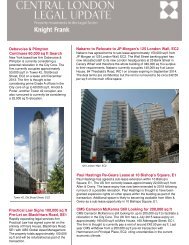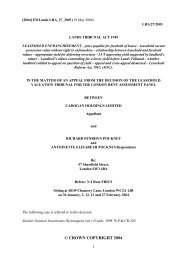40 Chelsea Square - Knight Frank
40 Chelsea Square - Knight Frank
40 Chelsea Square - Knight Frank
Create successful ePaper yourself
Turn your PDF publications into a flip-book with our unique Google optimized e-Paper software.
178. Mr Maunder Taylor, in his evidence before this Tribunal, has adopted what he describes<br />
as a “contractor’s method” of valuation, by which he has considered what an investor would<br />
have to pay to enable him to borrow in order to purchase a reversion and what profit he would<br />
require to persuade him to do so. This does not seem to us to be the exercise upon which we<br />
should be engaged in assessing the appropriate deferment rate for assessing a price to be paid<br />
in the market for the capital value to be realised at the end of the term, although, as we have<br />
said at paragraph – above, it may have relevance to the circumstances of a very short unexpired<br />
term. We have accepted the view that deferment rates are appropriately assessed by<br />
consideration of the return to a risk-free investment, appropriately adjusted for assessed risk,<br />
rather than being derived from borrowing rates, although, no doubt, the two rates will be<br />
linked. Borrowing rates, as represented by the Repo rate, are, however, policy determined in<br />
reaction to market factors, they are moved in fixed gradations, more or less frequently as the<br />
market reacts to changes. DB62 shows graphically the greater volatility of mortgage rates, as<br />
compared with the comparatively stable rate of return to long term index-linked gilts. In the<br />
period in question the latter continued a downward trend whilst the Repo rate was rising. This<br />
deviation in trend is, no doubt because of the long term nature of such investments, which, in<br />
our judgement, makes it a better comparator to investment in freehold reversions than shortterm<br />
borrowing rates.<br />
179. In our judgement, it is not until a change in the trend in risk-free yields has been<br />
established over a period of years, so that it is recognisable in the market for long term<br />
investments, or the continuance of the trend establishes a new level of yields, as can be seen in<br />
yields to conventional zero coupon gilts since the 1990s, that there will be changes that can<br />
properly be reflected by step gradations in deferment rates, assessed for the purpose upon<br />
which we are engaged. Changing yields in the property market, such as we have commented<br />
on above, would be helpful in identifying the time for adjustment of deferment rates once<br />
credibly established, but short term fluctuations should be discounted in making use of what we<br />
have identified as a valuation tool. For these reasons we make no adjustment for the dates of<br />
the valuations in these cases.<br />
Summary<br />
180. We are now able to give our decisions on the deferment rate for each property but before<br />
doing so we summarise our general conclusions as follows:-<br />
(1) The no-Act assumption in the statutory provisions regarding price and value<br />
excludes any assumption that the market would take into account the probability<br />
that Parliament might legislate in the future to confer the rights excluded<br />
(para 82).<br />
(2) Although market evidence is usually the best evidence of value, the extent of the<br />
right to enfranchise or to a lease extension is now so wide that there is unlikely<br />
to be dependable market evidence in any particular case. There is none in these<br />
appeals (paras 99 and 109).<br />
(3) There is not, and has never been, a binding “convention” that a fixed and<br />
constant deferment rate of 6% should be universally used. The deferment rate in<br />
each case must be individually determined on the evidence (para 112).<br />
42









